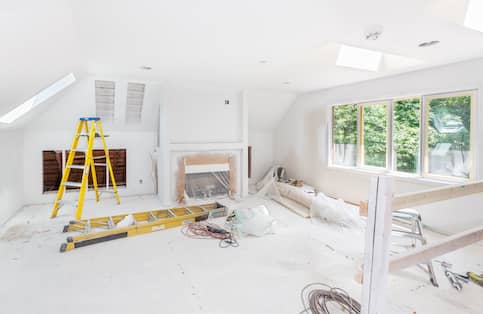A garage is much more than a place to park your car to protect it from the elements. A garage can provide any or all of the following:
- Extra storage
- Additional living space
- An office or meditation space
- Extra refrigerator/freezer space
- A warm, dry place to unload your vehicle
Whether it’s a simple one-car garage that’s detached from your house or a heated three-car attached one, you’ll likely need a loan to build a garage. If you’re considering adding some versatile and highly useful space to your property, you need a solid assessment of what kind of structure you need and how you’re going to finance it.
Financing A Garage: What To Consider
According to Forbes, in 2023 the average cost for a simple detached garage kit was $7,250, while a site-built, attached three-car garage with loft space could cost $50,000 or more. If you don’t have that much cash on hand, financing is your next best option.
And while even a heated attached garage is not considered extra square footage on your house, garage space does add value to your home that you’ll realize when you sell. So if there is a balance due on your garage financing, you may be able to pay it off when you sell the property.
Keep in mind, however, that any loan to build a garage is separate from your home mortgage and works differently.
See What You Qualify For
Buy A Home
Discover mortgage options that fit your unique financial needs.

Refinance
Refinance your mortgage to have more money for what matters.
Tap Into Equity
Use your home’s equity and unlock cash to achieve your goals.
Estimating Garage Build Costs
Construction costs for your new garage can vary widely depending on the scale of the project, type of structure and where you live. Not only are labor and material costs different from place to place, the cost of fees and permits are different in every community. Cost estimates provided here should be considered as ranges. You can get a more accurate estimate of your cost after getting multiple quotes from builders and talking with your city or county building department.
So, here are some of the options you have for garage space and rough estimates on costs:
- Carports: A carport is an open-air, supported roof structure, roughly covering an area 2-4 times the size of a vehicle. A carport usually covers a portion of your driveway near the house. It can stand independently or be attached to the side of your house, typically providing shelter over a side entrance. The average cost of a carport construction is between $3,074 and $9,527, according to HomeAdvisor.
- Attached and detached garages: The typical range for an attached or detached garage is between $16,430 and $40,314. The simplest difference is the attached garage needs one fewer wall, since it’s fourth wall is the house itself. With an attached garage you have no exposure to the elements when going from the house to the garage. It’s also easier to connect an attached garage to the main house’s electrical service, heat and plumbing if needed. However, if your lot is too narrow to build an attached garage, your only option might be a detached structure elsewhere on the property.
- Storage sheds: A storage shed can be anything from a pre-built structure you can buy retail and haul home on a trailer, to a kit that’s delivered to your home and you build on site. If you’re handy, you might even buy all the materials and build a shed yourself. Whether it’s built on the ground or a concrete slab, a shed is almost always an outbuilding. The typical range for a storage shed is between $1,500 and $10,000.
- Garage doors: The type of garage door you install can impact the overall construction cost by a few thousand dollars or more. A garage door can be made of many different materials and operate in different ways. It can have an automatic opener or operate manually. It can be a single panel door that tilts open or a rolling sectional door. The typical cost of buying a garage door and having it installed is between $700 and $2,000.
- Labor cost: Of the two main expenses in new construction — materials and labor — it is labor that varies more widely. Much depends on where you live. Workers in a more populated area with higher cost-of-living expect to be paid more than those in a rural area. Most studies show that construction labor costs can comprise from 20% to 50% of the project. You should have multiple quotes from contractors before beginning construction, and make sure they specify total costs for both labor and materials.
- Permit fees: Before beginning any garage or outbuilding construction, be aware of all building and zoning laws in the town and county where you live. There may be laws that restrict the type of structure you build and where it can stand on your property. And there will almost certainly be permit fees. The typical permit fee for a larger remodeling or construction project — such as a garage — is between $500 and $2,000. This cost may sting, but if you’re discovered building without a permit, you could face penalties that are even higher — or, worse, be ordered to remove the structure completely.
How To Finance A Garage: Loan Options
Let’s say you’ve decided on adding a detached garage on your property. After taking multiple quotes from builders, you’ve chosen one that estimates the project will cost $25,000. If you either don’t have that much in savings, or you would rather have your extra cash on hand for emergencies or other expenses, you may be eligible for one or more types of garage financing.
Home Equity Loans
A home equity loan — sometimes called a second mortgage — is a loan that uses your home as collateral. The difference between what you owe on your current mortgage and what the house is worth is called equity. You can borrow against that equity for a specific amount of money that must be repaid over a set period of time.
You typically repay a home equity loan with equal monthly payments over a fixed term at a fixed interest rate. However, just as with your mortgage, if you don’t repay the loan as agreed, your lender can foreclose on your home.
If you’re using this type of loan to build a garage, once your loan is approved you have access to your total loan amount immediately. You might pay your builder $5,000 to get the project started and an additional $20,000 when it’s complete. However you employ the funds, you must pay back the loan, with interest, according to the payment schedule set up at the start.
Home Equity Lines Of Credit (HELOCs)
Much like the home equity loan we just discussed, a home equity line of credit (HELOC) is another type of second mortgage that lets you borrow against the equity you’ve accrued in your home. The key difference is that a HELOC is not a lump sum loan. It’s an available line of credit that you can draw from much like a credit card.
As with other types of loans, lenders will want to make sure you have certain qualifications before extending a HELOC. These include:
- A solid credit score
- Assurance that you have at least 15% – 20% equity in your home
- A responsible payment history on your mortgage and other loans
- An acceptably low debt-to-income ratio
- Reliable income
A HELOC term is typically structured as two phases. In the first, the draw period, your line of credit is open and available for use. During this period, you can borrow from your line of credit as needed and make minimum or interest-only payments on the amount you borrow.
In the case of your garage build, you can make scheduled payments as the project moves forward. If you decide during the project to opt for a more expensive garage door and opener, you simply draw more cash to cover the overrun.
The second phase of a HELOC is called the repayment period. At this point, you won’t be able to continue to borrow from your HELOC and must begin making full monthly payments that cover the HELOC’s principal and interest. Understand that during the entire course of a HELOC loan, you are subject to fluctuations in interest rates, which can affect the amount of your monthly payments.
Personal Loans
A personal loan is a type of credit that you can use for most anything, including big purchases such as a new garage. It works as an installment loan, where you borrow a specified sum of money from a traditional bank, credit union or online lender and pay it back within a predetermined amount of time.
The key difference between a personal loan and the HELOC or home equity loan is that it does not use your home equity as collateral. It is granted — or denied — based on your demonstrated ability to pay back debt. Your interest rate will vary depending on your creditworthiness – the higher your credit score, the lower your rate may be, meaning you will pay less over the life of the loan.
Once you’ve signed for a personal loan, you can use the funds immediately to pay for your garage construction. If there is money left over, you can use it for whatever you’d like, such as a vacation or to pay down credit card debt.
You can also pay back your loan with your outstanding loan balance. Say you borrow $40,000 to cover your garage construction. You pay the builder $25,000 and then pay off a high-interest credit card balance of $5,000. You still have $10,000 of the loan available, but you could choose to pay all of that back with your next loan payment.
Construction Loans
A construction loan is a short-term loan, usually a year in length, which covers only the costs of custom home building or, in this case, a detached garage. When you take out a construction loan, you’ll usually make interest-only payments while the construction is being completed. Construction loans tend to have higher interest rates than most home loans because they are considered to be more risky for lenders.
Once your construction loan is approved, you’ll be able to start accessing the funds in conjunction with each phase of construction. An appraiser or inspector will check in on the build throughout the construction process. If progress is in accordance with the plan submitted by you and your builder, you can continue to have access to funds.
The most common type of construction loan is called a construction-to-permanent loan. The key advantage is that after the construction of your garage is complete, your construction loan automatically converts to a traditional mortgage and you will only pay closing costs once.
Qualification requirements for a construction loan are similar to those of a traditional mortgage, with some added steps:
- Credit score: Typically 620 or higher.
- Debt-to-income (DTI) ratio: Your monthly debts should be 45% or less of your monthly income.
- Down payment: Typically 20% of the project.
- Choice of builder: Your lender will want to approve the builder that will be constructing your new garage to ensure they are licensed and insured.
- Construction plan: In addition to your choice of builder, your lender will also need to approve your construction plan, including the contract, blueprints and a payment schedule.
Cash-Out Refinance
A cash-out refinance is a process that lets you turn some of your home equity into cash at closing. Unlike a home equity loan or HELOC, which are like a second mortgage, a cash-out refinance replaces your current mortgage with a new, larger mortgage.
As your mortgage matures, you gain equity in your home either because your home increases in value, you pay down your mortgage principal through monthly payments, or both.
In a cash-out refinance you take advantage of the equity you’ve built over time and get cash for taking on a larger mortgage. In other words, you borrow more than you owe on your mortgage and pocket the difference. This money is yours free and clear to use for a new garage, to consolidate debt, or whatever you’d like.
The potential downside of taking a cash-out refinance is that the terms of your new mortgage may include a higher interest rate, larger monthly payment, or even private mortgage insurance (PMI). Make sure you understand your new loan before taking a cash-out refinance.
Alternatives To Financing A Garage
If you can’t qualify for a loan or are unwilling to take on more debt, there are alternative ways to pay for your new garage, though each has pros and cons.
Cash
Sometimes the most direct way is the best way. If you have all the cash available to finish your garage project, you can avoid all the steps of financing by simply writing a check.
The downside to paying cash is that it depletes your reserves and could impede your ability to pay for unexpected expenses or emergencies that can pop up in the future.
Private Loan From Acquaintance
If you’re fortunate enough to have a parent, friend or other close relation who is willing to lend you cash to pay for your garage build, it’s a nice thing, but it can be fraught with problems. The biggest is that it can harm the relationship. If someone you know lends you money, you are always literally indebted to that person until you have paid them back, which can take years. You should give serious consideration to borrowing thousands of dollars from someone close to you, even if it’s a wealthy parent.
The Bottom Line
A new garage, whether it’s attached to your house or not, can add useful space that makes living more comfortable and convenient. Whether it’s a simple shed or a three-car attached garage, there are financing options available that allow you to build now and pay for the project over time.

David Collins
David Collins is a Senior Blog Writer for Rocket Companies. He has experience in communications for the automotive industry, reference publishing, and food and wine. David holds a degree in English from the University of Michigan.












